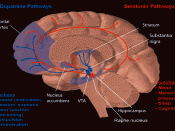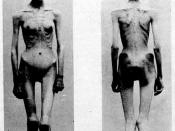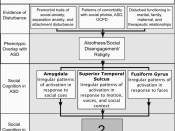Anorexia nervosa is a life threatening eating disorder affecting millions of teenagers and adults worldwide. Anorexia can be defined as a maintenance of less than fifteen percent body fat through self starvation. Ninety-five percent of anorexics are women between the ages of twelve and eighteen; however, in the past twenty years, this disorder has become a growing threat to high school and college students alike. An extremely serious disease, anorexia nervosa ultimately leads to problems such as amenorrhea, osteomalacia, and depression in sufferers.
Anorexia usually begins through an individual's desire to lose weight . Most sufferers have distorted self images and believe to be overweight, even though twenty percent of the time he or she is not. The skewed self image produced by this disease also often results in the anorexic acquiring a low self-esteem. The behavioral symptoms of anorexia nervosa are counting calories, eating little food, "playing" with food, disguising food intake, dressing in layers to hide the distinct weight loss, and to avoid social activities where eating is involved.
These indications are difficult to distinguish by outsiders because the behavior is not out of the ordinary and is easily overlooked.
Severe symptoms of anorexia are classified as such because they result in devastating physical side effects and even death. The dropping of body fat due to self-starvation can cause one of the most serious consequences of this illness in women: amenorrhea, an absence of the menstrual cycle. Amenorrhea can put stress on tiny bones that result in their breakage and also interferes with fertility. The sufferers level of estrogen, a reproductive hormone that protects the body against heart diseases and osteoporosis, also usually drops significantly.
Osteomalacia, a disease occurring mostly in adult women that results from a deficiency in vitamin D or calcium, is another adverse consequence of...


